Templates
You can configure and manage new templates and template groups on the Templates screen. Further, you can organize them into groups for easy access and management.
You will view the following template details on the screen:
- ID: Specifies the Unique ID of the template.
- Channel: Specifies the agent's message Channel (SMS/Email/Facebook/Twitter/LiveChat/Apple Messages for Business /WhatsApp/API) throughout the chat.
- Template: Specifies the Customized Message with the variables in tags.
- Action: Specifies the activities that can be performed on the template (i.e.) Edit and Delete.
You can perform the following actions on the Templates screen:
- Create a New Template Group
- Delete Template Group
- Add New Template
- Edit Template
- Delete Template
- Order Templates
Detailed information on each of the features is provided in the subsequent sections.
Upload Templates
Upload templates functionality helps bulk upload templates at once by reducing the time to create templates.
To upload templates, follow these steps:
- Navigate to Customer care console > Settings> Manage > Templates.
- Click the Upload Template on the top-right corner of the templates screen.
The following page appears on the screen.
- Click Download the sample file here link.
A sample file is downloaded. - Open the sample file.
Note
We recommend using ABC instead of AMB terminology in the Upload Templates file, as we are yet to update it in the backend systems.
- Enter all the details, such as Channel Name, Template Group Name, Template Name, Template Text, and Lock Template (Yes/No), in the file, and upload this file to create multiple templates.
Note
- The upload templates file name must be unique.
- Enter all the values in the sample file, as all fields are mandatory.
- Upload the file only in .csv format.
- Compose the template text as per the configured character count for each channel template on the application. Also, the Text Template column supports all the Unicode characters.
- Use the Pipe symbol (|) as a delimiter to enter multiline text in the Text column.
- Even If a single template text record in the upload templates file ends with a delimiter-pipe symbol (|), all the records in that file must end with the same delimiter.
- Delete the help notes before uploading the Upload Templates spreadsheet.
- Save the file.
- Click the Upload File button and upload the file.

Note
If any conflicts exist in the uploaded file, you will view the status on the Upload Templates screen. You can download the file to view the errors and fix them to re-upload.
- Click Proceed. The following success message appears on the screen.
- Click the Track Upload Status button on the top-right corner of the Upload Templates screen.
You will navigate to the following screen.

- Select the Show Activity Date Range and click Apply.
- Click Search.
The relevant search results will appear on the screen. - You can further search the table results by directly entering the file name in the search field available under the Show Activity Between search field.
You can view the status of the uploaded file in the Status column. - If the uploaded file fails the validation or gets uploaded with errors, you will view a report in the Actions column.
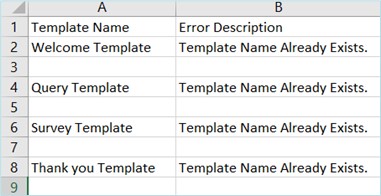
- You can download the report, view the errors, fix the errors, and re-upload the file to create templates.
Create New Template Group
To create a new template group, follow these steps:
- Navigate to Customer care console > Settings> Manage > Templates.
- Click the Add icon adjacent to the Template Groups. The Add Template Group pop-up window appears.
- Enter Group Name and click Add.
The success message appears on the screen.
Delete Template Group
To delete a template group, follow these steps
- Navigate to Customer care console > Settings> Manage > Templates.
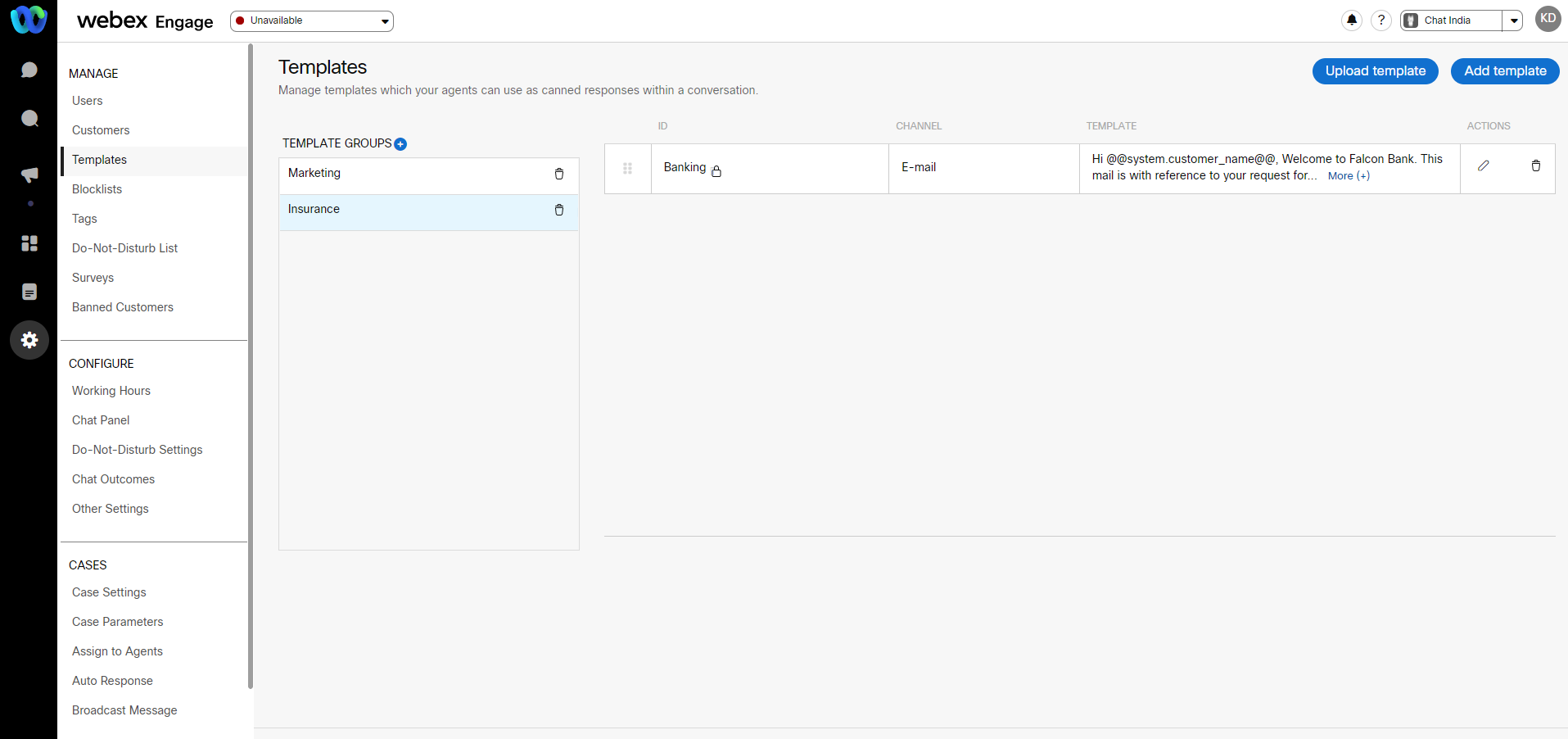
- Click the Delete icon adjacent to the template group name that needs to be deleted.
A confirmation pop-up window is displayed.
- Click Ok .
The success message appears on the screen.
Add New Template
This feature enables the team manager to add message template formats for each channel.
To create a new template, follow these steps:
- Navigate to Customer care console > Settings> Manage > Templates.

- Select a Template group in which you want to create a template.
- Click the Add Template button on the top-right corner of the templates screen.
You can create the templates for all channels or any of the following channels:
- SMS
- Livechat
- API
- Apple Messages for Business
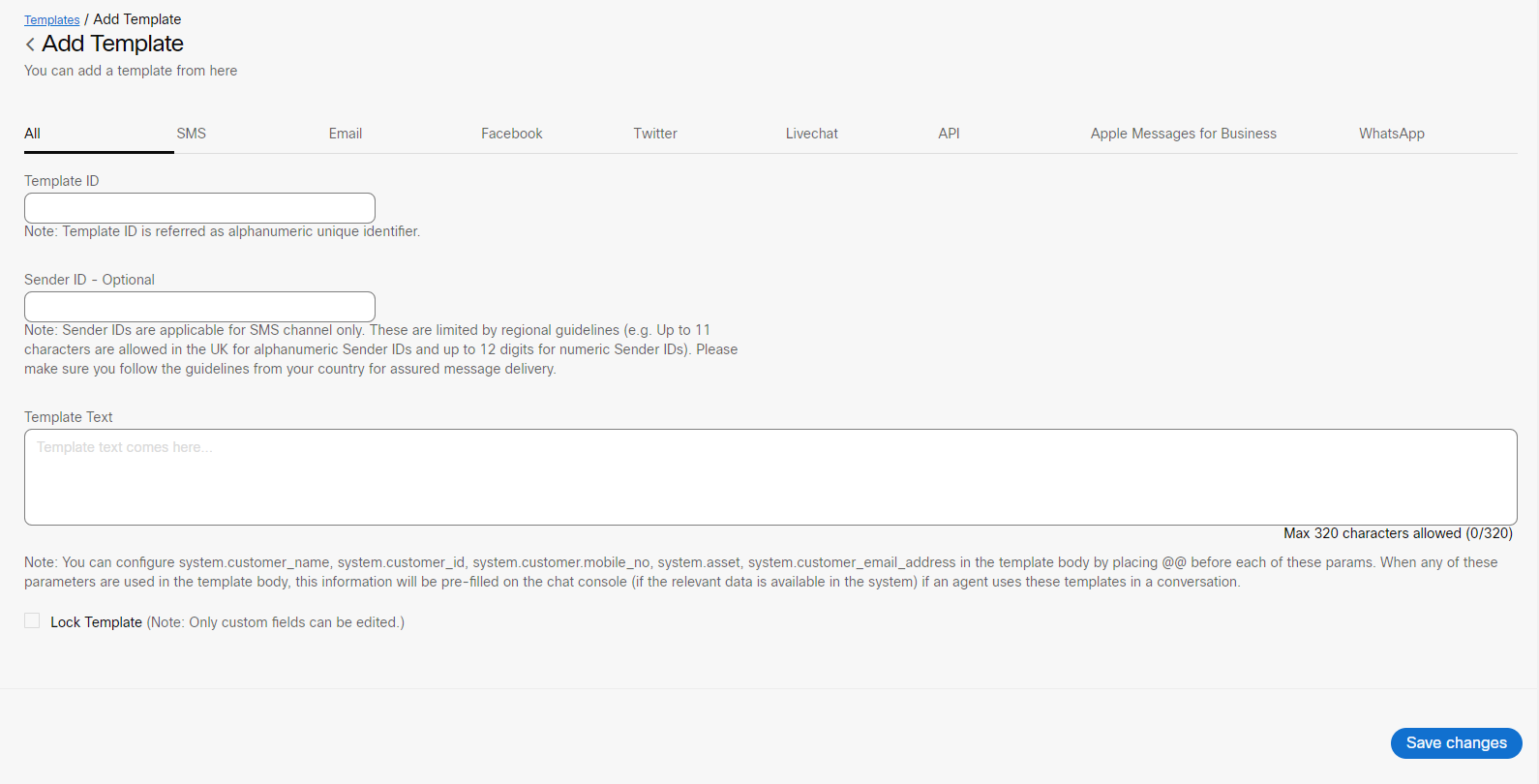
SMS Template
To create an SMS template (or All Channels template), follow these steps:
- Click the All or SMS tab.
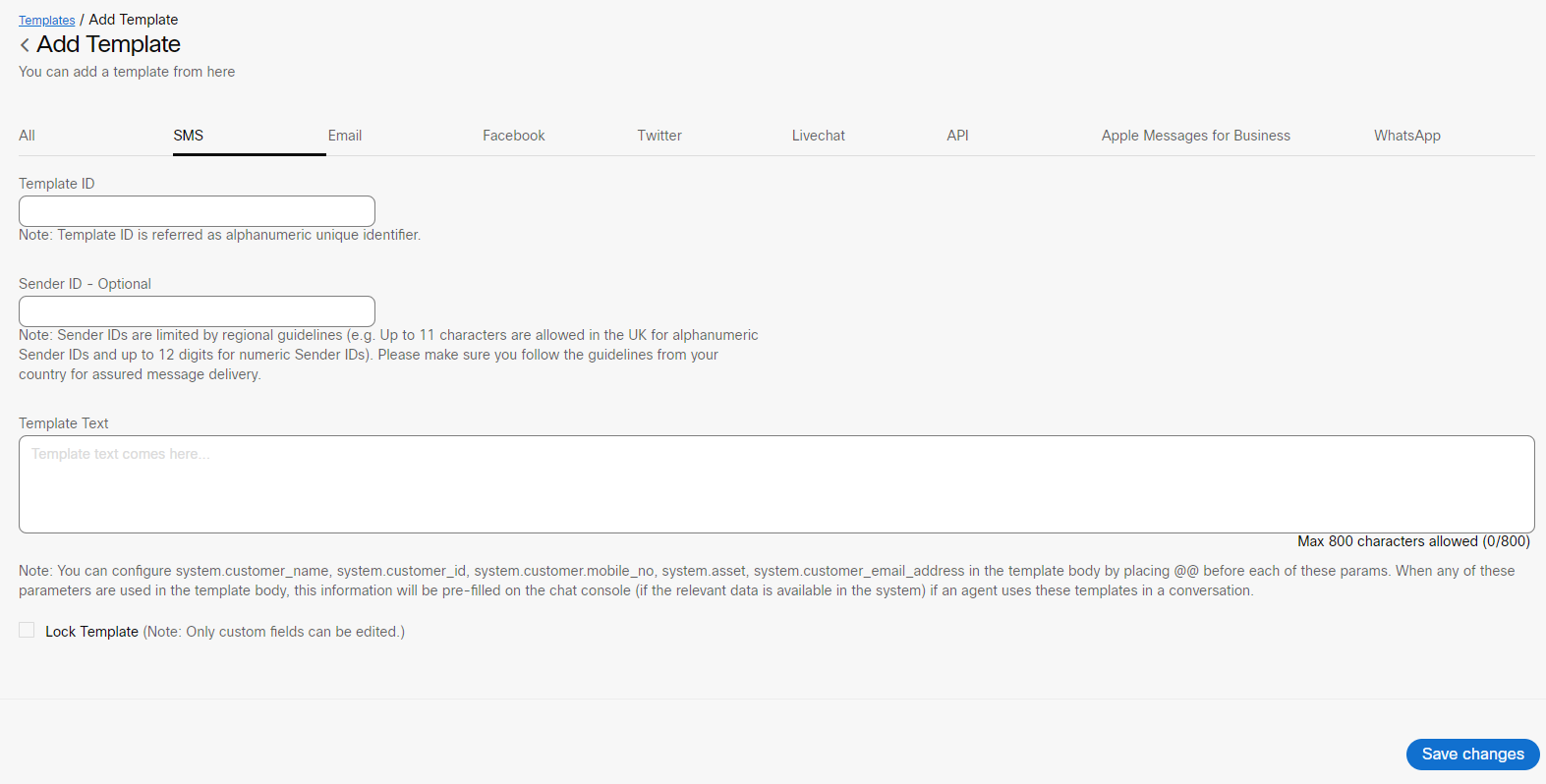
- Enter a Unique ID in the Template ID field.
Note
The default Sender ID (short code assigned to the team if SMS is enabled as a Channel) is loaded automatically while creating a template. This feature allows the team manager to easily create and keep track of the templates.
- Custom Fields: Enter custom/editable fields in the template body using chevron(<>) brackets. Custom fields are editable fields even in locked templates.
- System Parameters: Enter @@ to view the list of system parameters. You can select any of these parameters and compose the te. When any of these parameters are used in the messages, the corresponding values are dynamically substituted when an agent uses/selects these templates in a conversation.
Note:
When the relevant values are not available for the configured parameters in the template body, such parameters will be rendered in chevron braces and highlighted in yellow in the chat console.
- Compose the message in the Template Text. You can enter a maximum of 800 characters in the text box.

- Select the Lock Template checkbox to lock specific templates. Only custom/dynamic fields can be edited by the agents when locked. A lock icon is displayed corresponding to the template. Refer to the image below.
- Click Save changes.
The success message appears on the screen.
Email Template
To create an Email template, follow these steps:
- Click the Email tab.
The following screen appears.
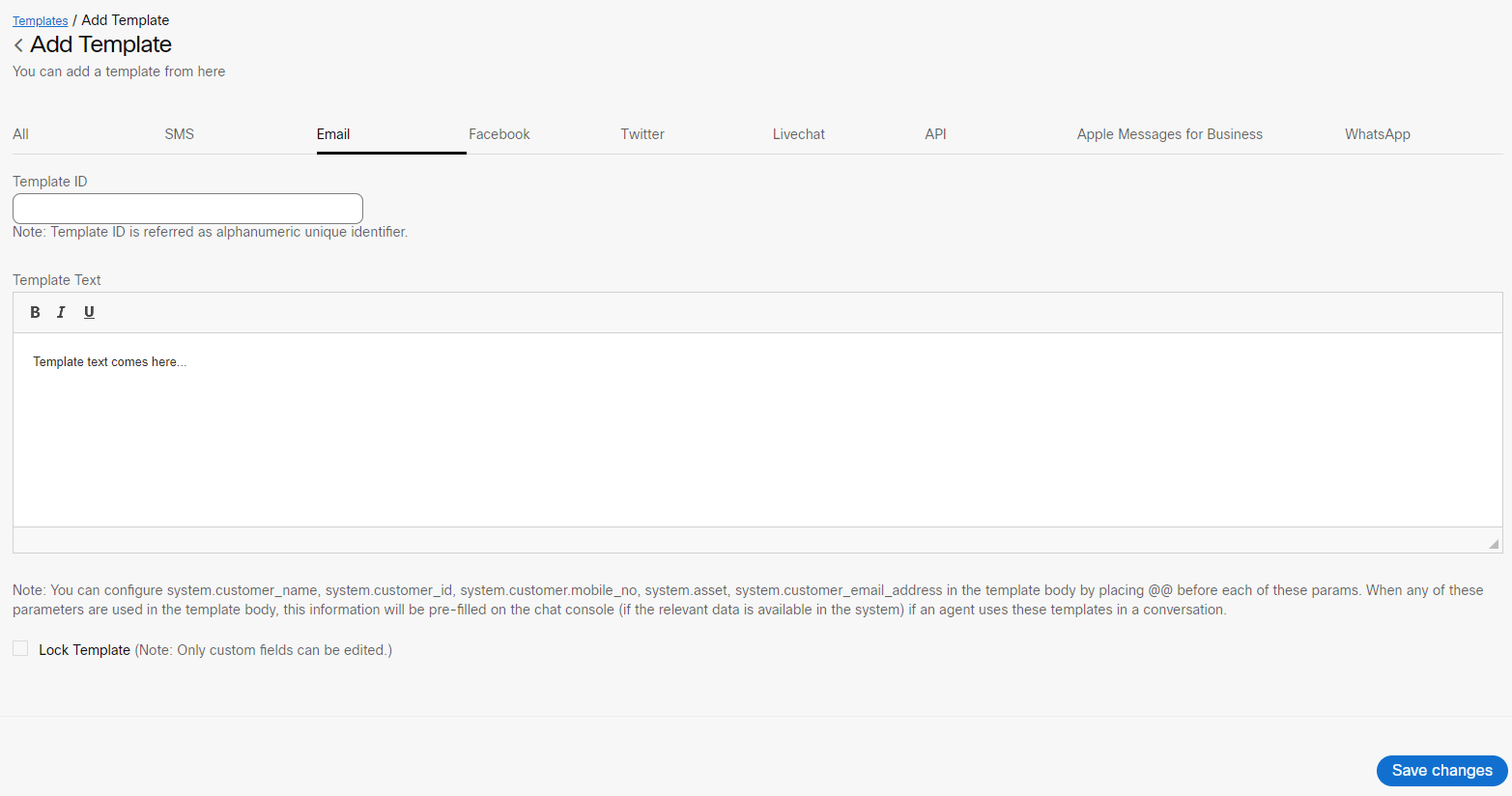
- Enter a Unique ID in the Template ID field.
- Compose the message in theTemplate Text field.
- Custom Fields: Enter custom/editable fields in the template body using chevron(<>) brackets. Custom fields are editable fields even in locked templates.
- System Parameters: Enter @@ to view the list of system parameters. You can select any of these parameters and compose the template text. When any of these parameters are used in the template text, the corresponding values are dynamically substituted when an agent uses/selects these templates in a conversation.
Note:
When the relevant values are not available for the configured parameters in the template body, such parameters will be rendered in chevron braces and highlighted in yellow in the chat console.
- Enter the message in the Template Text field and apply rich formatting styles.
- Select the Lock Template checkbox to lock specific templates. Only custom/dynamic fields can be edited by agents when locked. A lock icon is displayed corresponding to the template.
- Click Save changes.
The success message is displayed on the screen.
Facebook Template
To create a Facebook template, follow these steps:
- Click Facebook tab. The following screen appears.

You can create Plain Text, Action, and Multimedia templates.
- Enter a Unique ID in the Template ID field.
- By default, the Text Template radio button is selected. Compose the message in the Template Text field.
- Custom Fields: Enter custom/editable fields in the template body using chevron(<>) brackets. Custom fields are editable fields even in locked templates.
- System Parameters: Enter @@ to view the list of system parameters. You can select any of these parameters and compose the template text. When any of these parameters are used in the template text, the corresponding values are dynamically substituted when an agent uses/selects these templates in a conversation.
Note:
When the relevant values are not available for the configured parameters in the template body, such parameters will be rendered in chevron braces and highlighted in yellow in the chat console.
- Click Save changes.
- To create an Action Template, select the Action Template option. This option is used when a quick response is expected from the customer. The message is sent with images and buttons, wherein the customer can respond with a button click.
- Click the Upload Image to browse and select the required image.
Note
The application supports images with an aspect ratio of 1.91:1 only.
- Enter Button Names and select Button Type from the drop-down list.
- If you select the WEB URL Button Type, then enter the Call URL.
- Compose the message in the Template Text field.
- To create a Multimedia template, select the Multimedia Template button to view the related parameters that must be set. This option configures Multimedia templates in addition to plain text templates. The multimedia types supported are as follows:
- Image
- Audio
- Video
- File
- Select the media type in the Media Type field and enter the respective downloadable URL in the Enter Media URL field.
- Select the Lock Template checkbox to lock a template. Only custom/dynamic fields can be edited by the agents when locked. A lock icon is displayed corresponding to the template.
- Click Save changes to create the template. The success message appears on the screen. The newly added templates will be displayed under the selected template group.
Twitter Template
To create a Twitter template, follow these steps:
- Click the Twitter tab on the add template page.
The following screen appears.
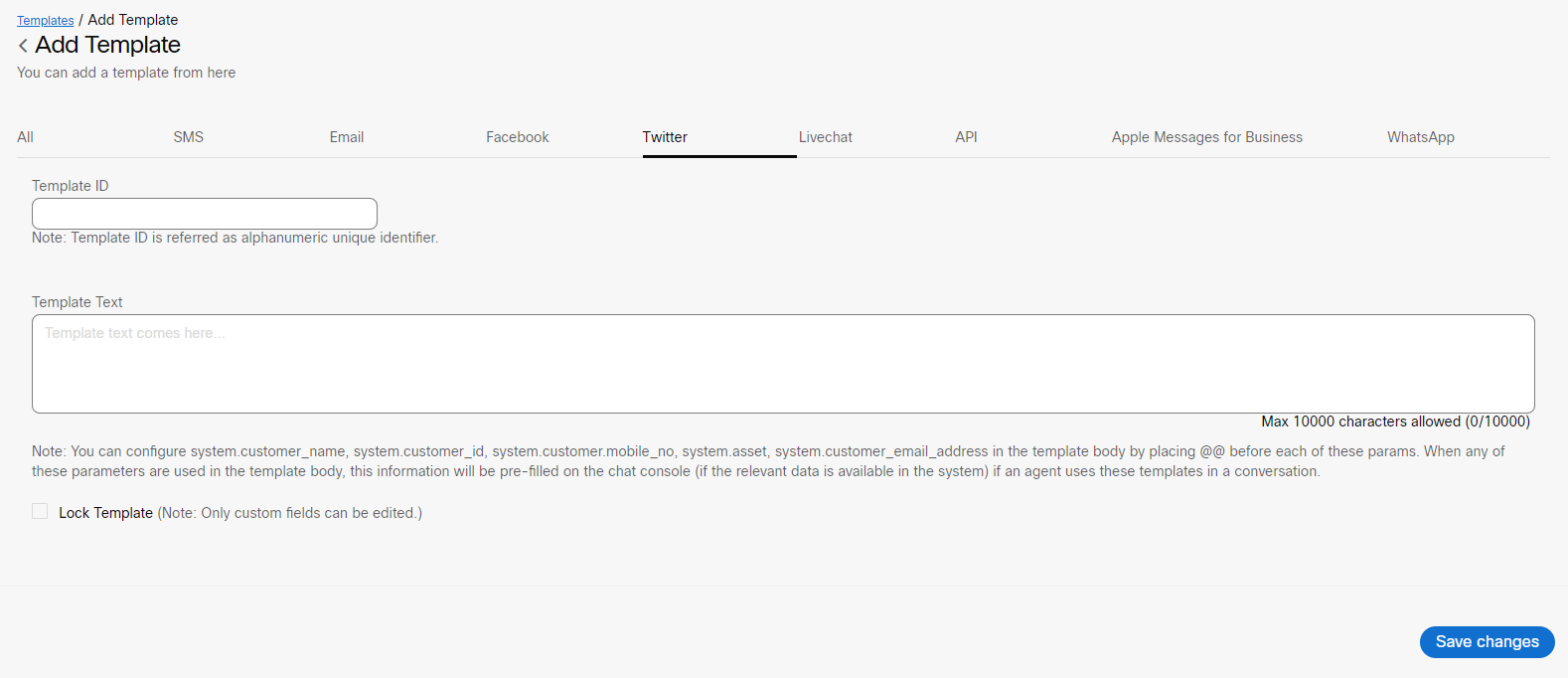
- Enter a Unique ID in the Template ID field.
- Custom Fields: Enter custom/editable fields in the template body using chevron(<>) brackets. Custom fields are editable fields even in locked templates.
- System Parameters: Enter @@ to view the list of system parameters. You can select any of these parameters and compose the template text. When any of these parameters are used in the template text, the corresponding values are dynamically substituted when an agent uses/selects these templates in a conversation.
Note:
When the relevant values are not available for the configured parameters in the template body, such parameters will be rendered in chevron braces and highlighted in yellow in the chat console.
- Compose the message in the Template Text field.
- Select the Lock Template checkbox to lock specific templates. Only custom/dynamic fields can be edited by agents when locked. A lock icon is displayed corresponding to the template.
- Click Save changes to create the template.
The success message appears on the screen.
Livechat Template
To create a Livechat template, follow these steps:
- Click the Livechat tab on the Add Template page.
The following screen appears.
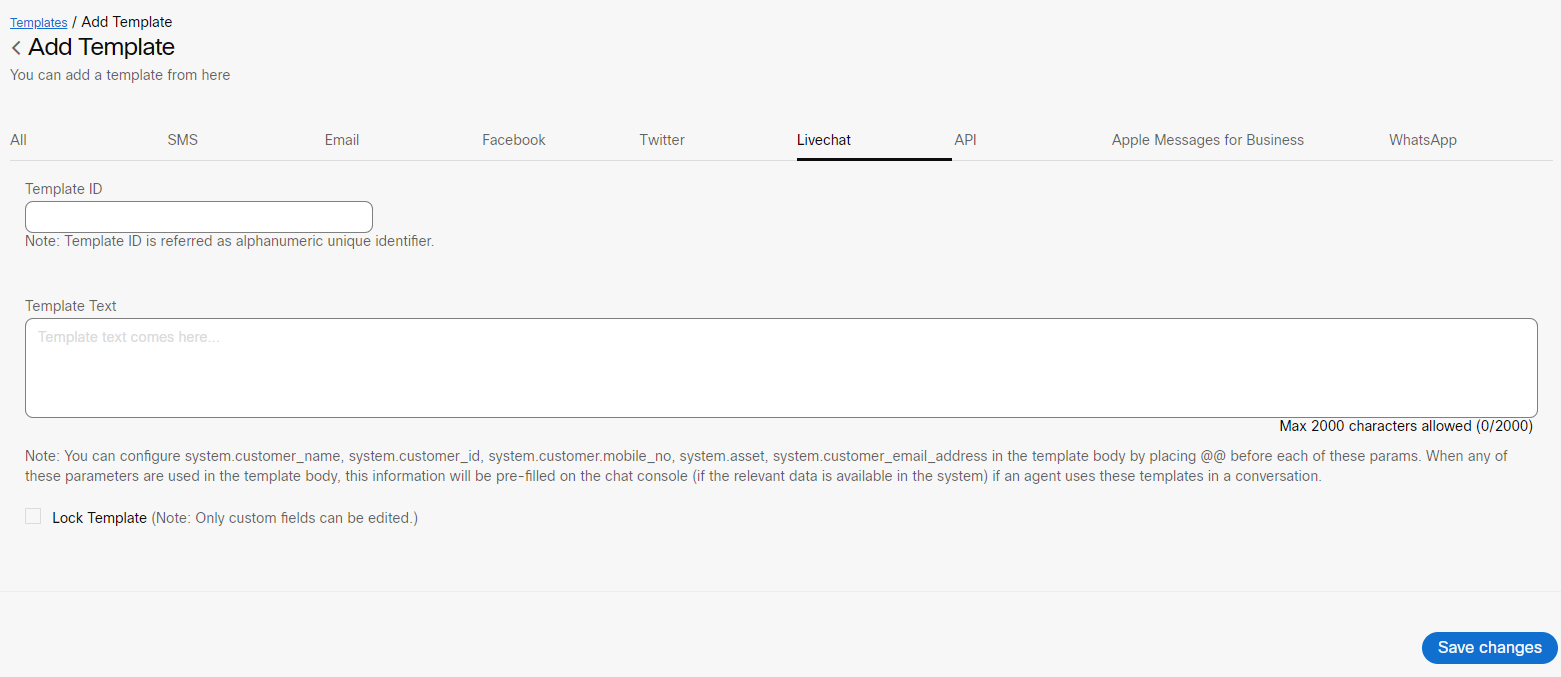
- Enter a Unique ID in the Template ID field.
- Custom Fields: Enter custom/editable fields in the template body using chevron(<>) brackets. Custom fields are editable fields even in locked templates.
- System Parameters: Enter @@ to view the list of system parameters. You can select any of these parameters and compose the template text. When any of these parameters are used in the template text, the corresponding values are dynamically substituted when an agent uses/selects these templates in a conversation.
- Compose a message in the Template Text field.
Note:
When the relevant values are not available for the configured parameters in the template body, such parameters will be rendered in chevron braces and highlighted in yellow in the chat console.
- Select the Lock Template checkbox to lock specific templates. Only custom/dynamic fields can be edited by the agents when locked. A lock icon is displayed corresponding to the template.
- Click Save changes to create the template.
The success message appears on the screen.
API Template
To create an API template, follow these steps:
- Click the API tab on the Add Template page.
The following screen appears.
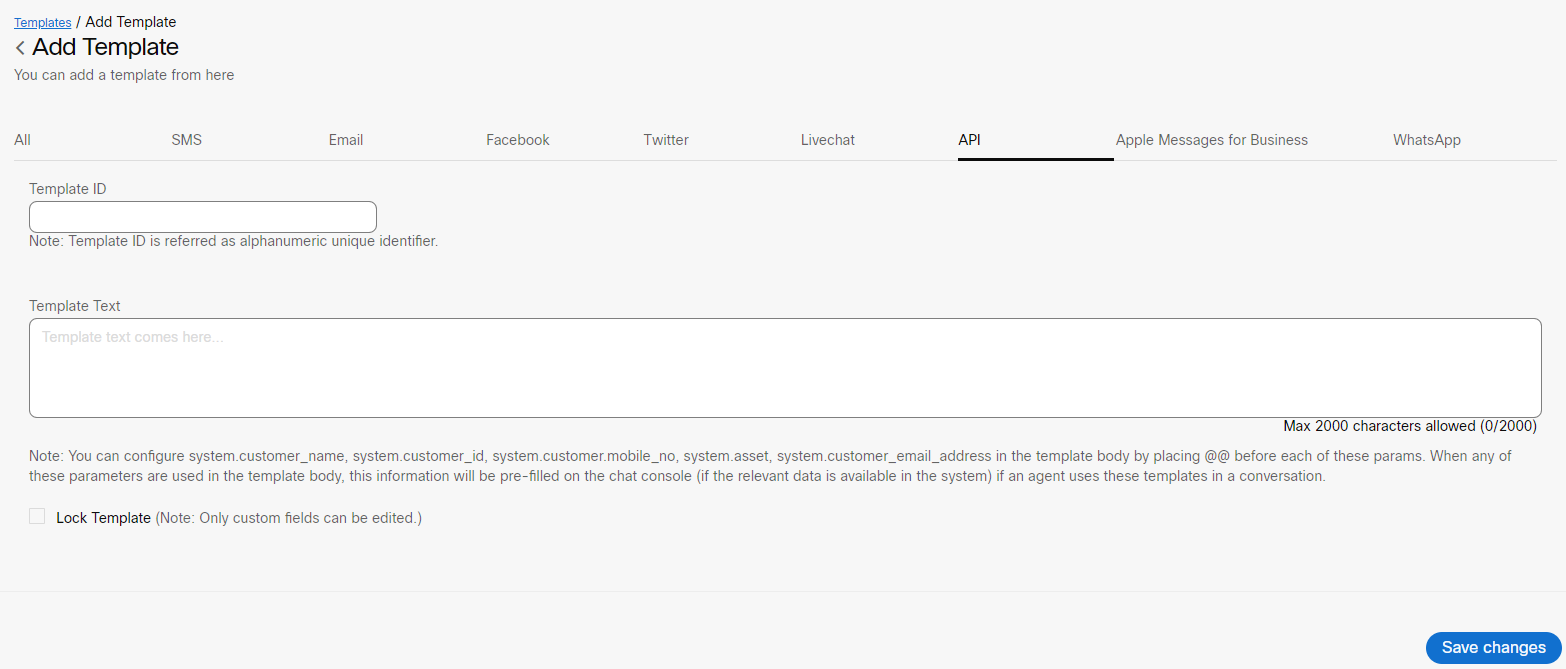
- Enter a Unique ID in the Template ID field.
- Custom Fields: Enter custom/editable fields in the template body using chevron(<>) brackets. Custom fields are editable fields even in locked templates.
- System Parameters: Enter @@ to view the list of system parameters. You can select any of these parameters and compose the template text. When any of these parameters are used in the template text, the corresponding values are dynamically substituted when an agent uses/selects these templates in a conversation.
Note:
When the relevant values are not available for the configured parameters in the template body, such parameters will be rendered in chevron braces and highlighted in yellow in the chat console.
- Compose the message in the Template Text field.
- Select the Lock Template checkbox to lock specific templates. Only custom/dynamic fields can be edited by agents when locked. A lock icon is displayed corresponding to the template.
- Click Save changes to create the template.
The success message appears on the screen.
Apple Messages for Business Template
To create an Apple Messages for the Business template, follow these steps:
- Click the Apple Messages for Business tab on the Add Template page.
The following screen appears.
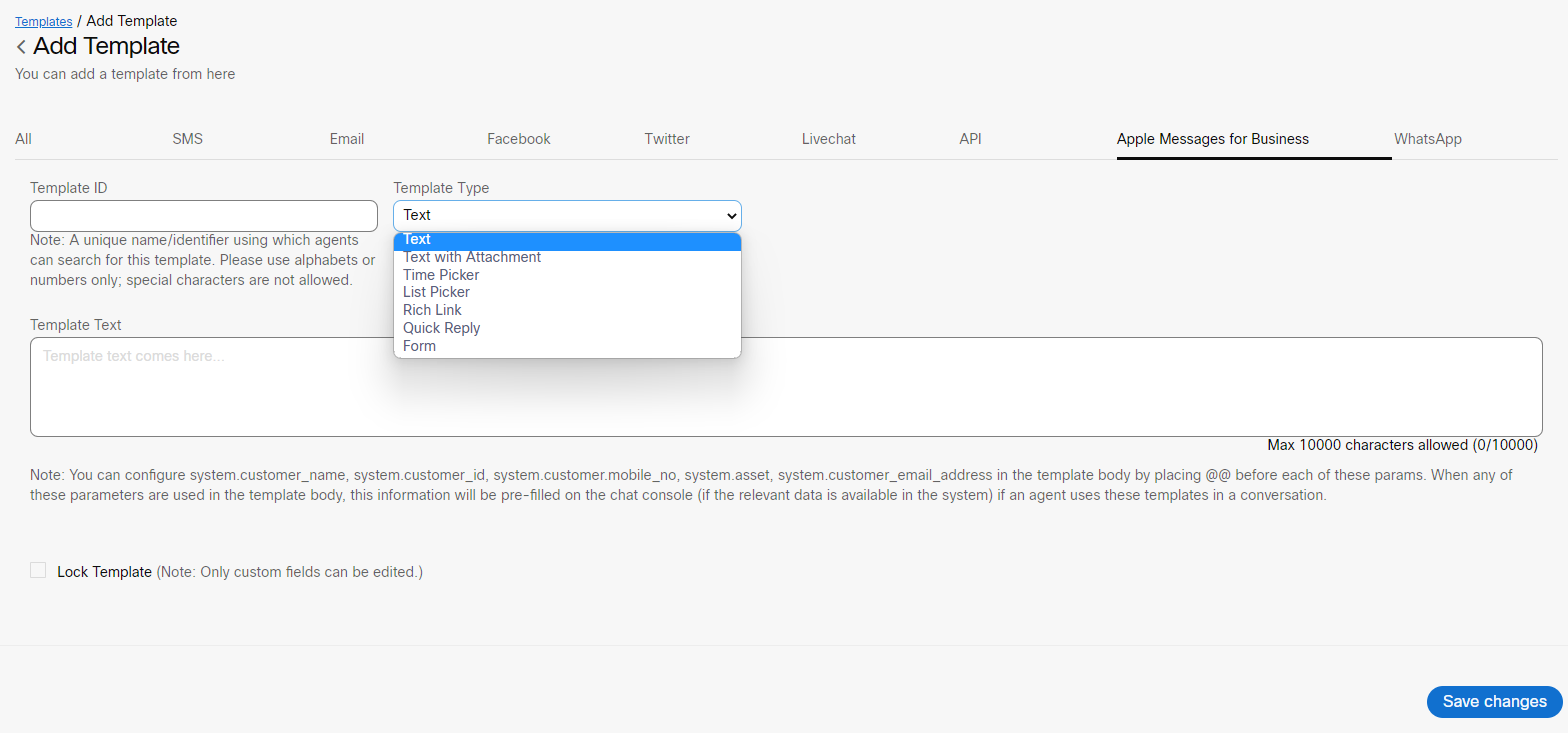
- Enter a Unique ID in the Template ID field.
- Select template type - the template type can be Text, Text with Attachment, Time Picker, List Picker, Rich Link, Quick reply, and Form.
- If you select the Text Template type, compose the message in the Template Text field. You can enter a maximum of 10000 characters in this field.
- If you select the Text with Attachment template type, the following options appear on the screen.
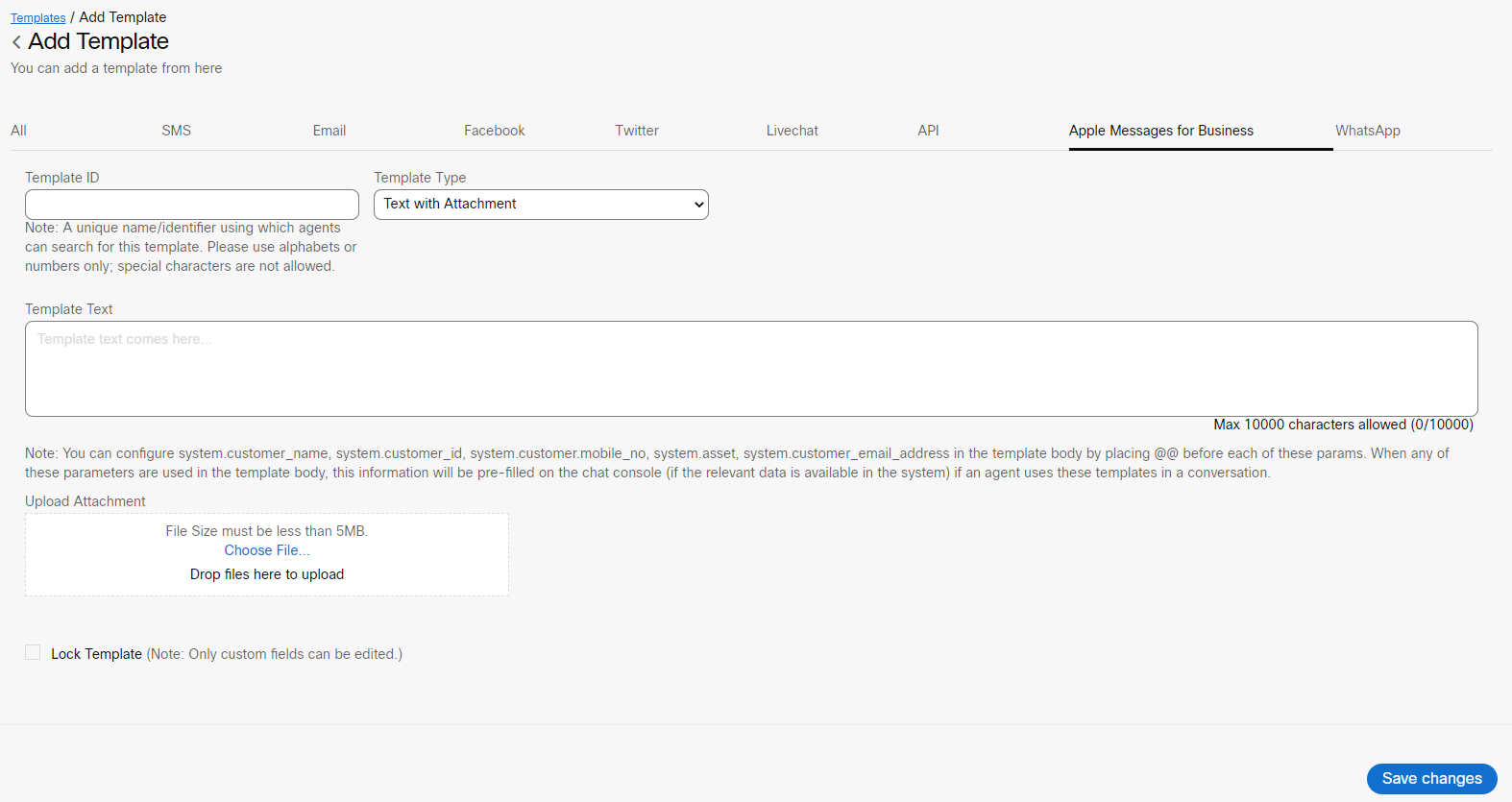
- Custom Fields: Enter custom/editable fields in the template body using chevron(<>) brackets. Custom fields are editable fields even in locked templates.
- System Parameters: Enter @@ to view the list of system parameters. You can select any of these parameters and compose the template text. When any of these parameters are used in the template text, the corresponding values are dynamically substituted when an agent uses/selects these templates in a conversation.
Note:
When the relevant values are unavailable for the configured parameters in the template body, such parameters will be rendered in chevron braces and highlighted in yellow in the chat console.
- Compose the message in the Template Text field.
- Click Choose File/ Drop Files Here to upload an attachment. The maximum upload file limit is ≤ 5 MB.
- Select the Lock Template checkbox to lock specific templates. Only custom/dynamic fields can be edited by the agents when locked. A lock icon is displayed corresponding to the template.
- If you select the Time Picker Template type, the following options appear on the screen.
Received Message: In this section, an admin can configure received messages.
- Enter Title, Subtitle, and Click Choose File/ Drop files here to upload an attachment. The maximum upload file limit is ≤ 5 MB.
- Here, you can configure the uploaded image and view it as an icon, small and large sizes.
- Event Details: Turn ON this toggle to pre-fill the details (manual agent intervention). When this field is enabled, the following options appear.
- Enter the Event Title,Location Details, and Show on Map details.
- Time Slots: Select the date, time, and duration from respective fields.
- Click the Add icon to add more time slots.
Note:
The team manager can create maximum of Ten slots.
- Click the - icon to delete a time slot.
Reply Message: In this section, a reply message can be configured in this section. - Enter Title, Subtitle, and Click Choose File/ Drop Files Here to upload an attachment. The maximum upload file limit is ≤ 5 MB.
Here, the admin can configure the uploaded image in the icon, small, and large sizes.
- If you select the List Picker Template type, the following options appear on the screen.
- Received Message: In this section, received messages can be configured.
- Enter Title, Subtitle, and Click Choose File/ Drop files here to upload an attachment. The maximum upload file limit is ≤ 5 MB.
- Here, the team manager can configure the uploaded image in the icon, small, and large sizes.
- List Details: Enter Section Title.
- To have multiple sections for a section, select the Allow Multiple Sections checkbox.
- Enter Item Name and Item Subtitle.
- Click the Drop Files Here to Upload to upload an image.
- To add items to the list, click the Add icon.
- To further add a section, click Add Section.
- To delete a section or a list item, click the - icon.
Reply Message: In this section, you can configure reply messages. - Enter Title, Subtitle, and Click Choose File/ Drop files here to upload an attachment. The maximum upload file limit is ≤ 5 MB.
Here, you can configure the uploaded image in the icon, small, and large sizes. - If you select the Rich Link template type, the following options appear.
- Enter the Title and URL.
- Select the file type (Image / Video) from the drop-down list. Click Choose File and upload Image/ Video.
Note:
The maximum upload file limit is ≤ 5 MB. Video file must be in MP4 format.
- If you select the Quick Reply Template type, the following options appear on the screen.

- Enter the Question in the Title field. You can enter a maximum of 75 characters in the question field.
- Enter the Quick Reply option in the Add options field. You can add a minimum of two and up to five customizable options for each question, with a maximum character limit for each option being 50.
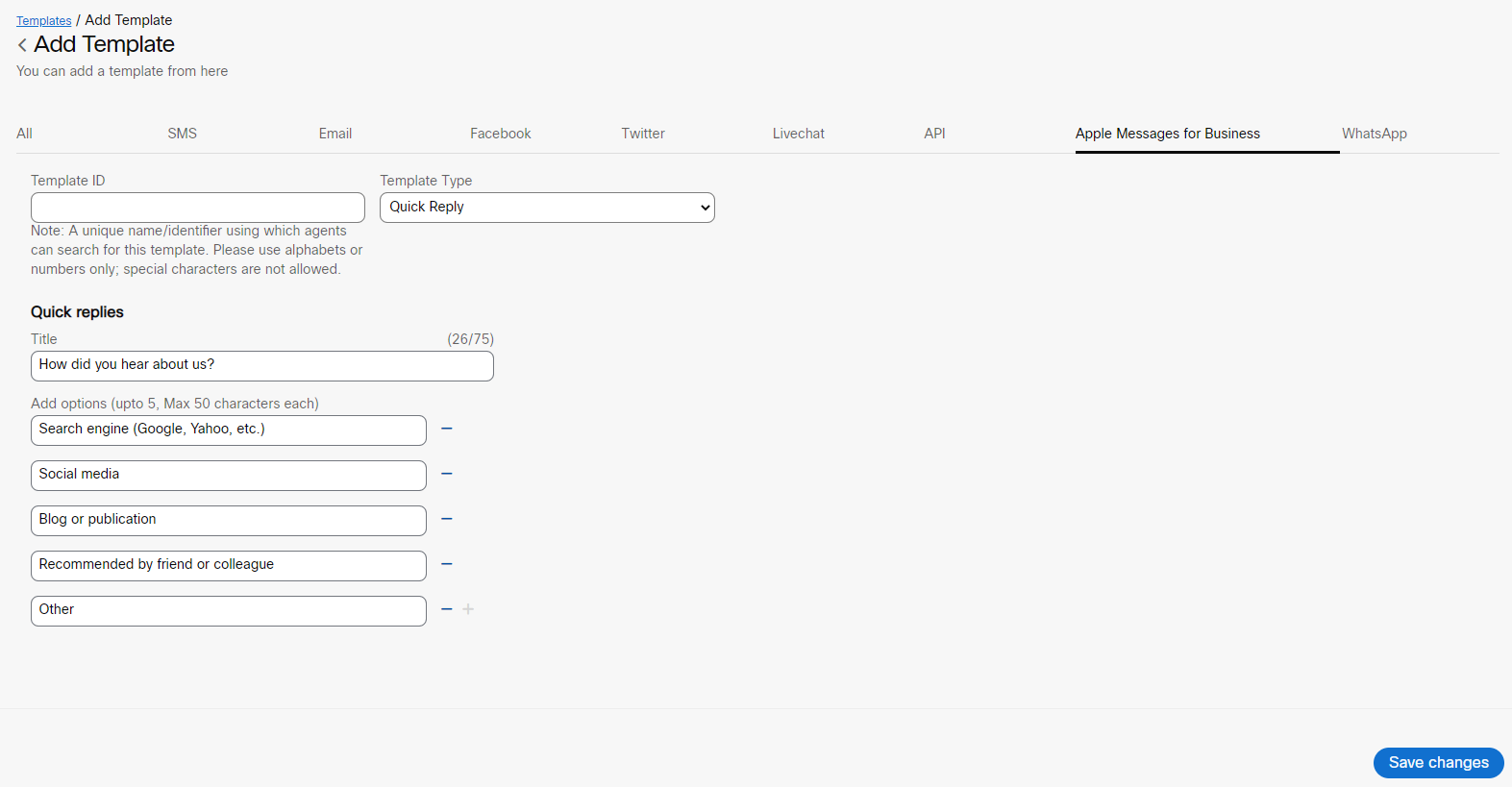
- If you select the Form Template type, the following options appear on the screen.
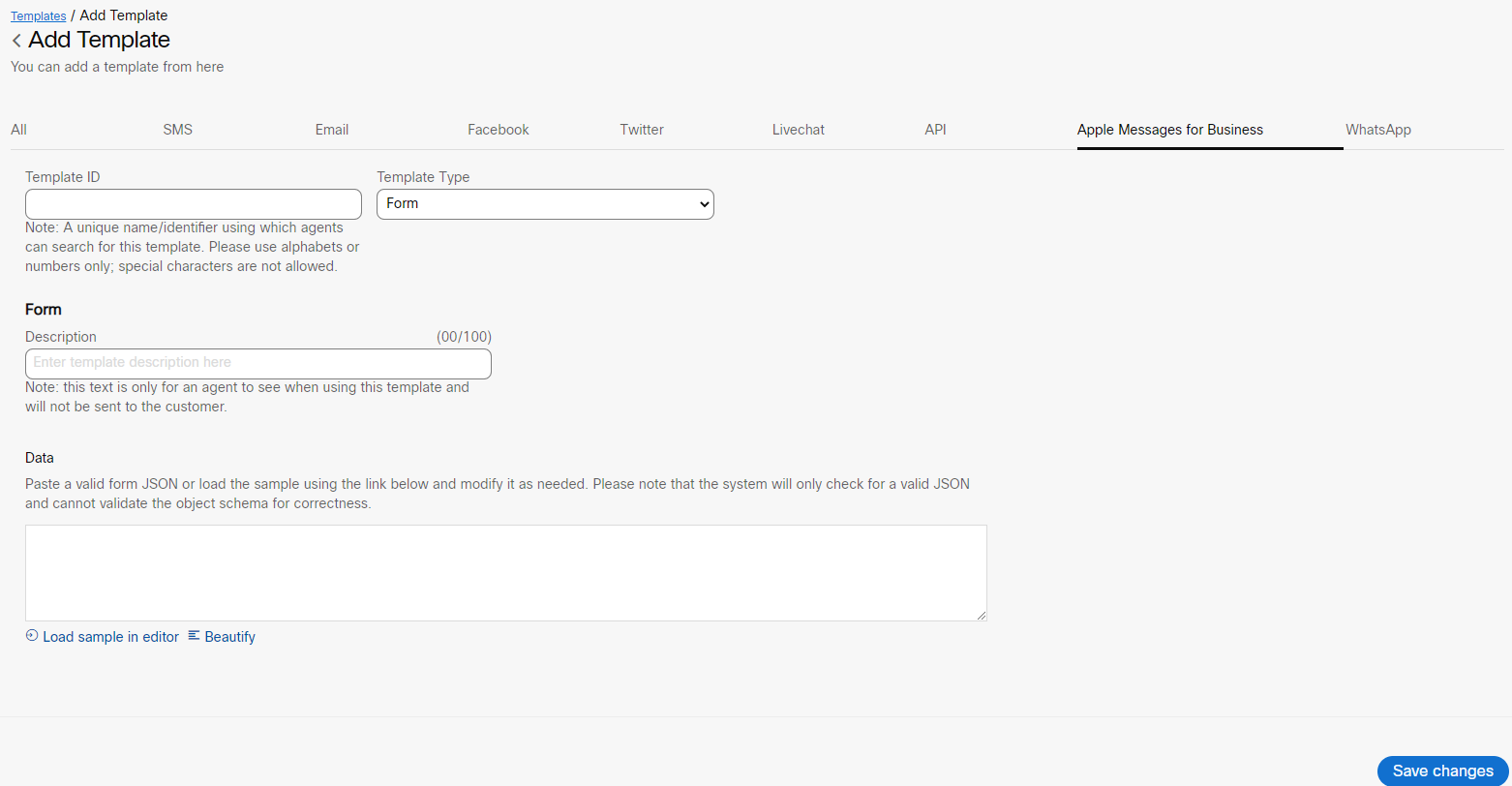
- Enter the Template description in the Description field. The agents can use the configured description to search the templates.
- Paste a valid form JSON. You can even load the sample JSON by clicking the Load sample in editor available below the Data field and customize it based on need.
- You can click the Beautify link beside the Load sample in the editor link to format and make the JSON readable.

- Click Save changes.
The success message appears on the screen.
WhatsApp Template
To create a WhatsApp template, follow these steps
- Click the WhatsApp tab on the Add Template page.
The following screen appears.

- Enter a Unique ID in the Template ID field.
- Custom Fields: Enter custom/editable fields in the template body using chevron(<>) brackets. Custom fields are editable fields even in locked templates.
- System Parameters: Enter @@ to view the list of system parameters. You can select any of these parameters and compose the template text. When any of these parameters are used in the template text, the corresponding values are dynamically substituted when an agent uses/selects these templates in a conversation.
Note:
When the relevant values are unavailable for the configured parameters in the template body, such parameters will be rendered in chevron braces and highlighted in yellow in the chat console.
- To create a text template, select the Text radio button and enter the template text in the Template Text field. The maximum character limit allowed in the Template Text field is 4096 characters.
- To create an attachment template, select the Attachment radio button.
- Click Choose File/ Drop Files Here to upload an attachment. The maximum upload file limit is 64 MB.
Note:
To initiate a conversation with a customer, WhatsApp requires you to use pre-approved WhatsApp Business (WAB) registered message templates.
- To create WAB registered message, select the WAB registered message radio button. The following options appear on the screen:
- Select a category from the Category drop-down list.

- Select a language from the Language drop-down list.
- Select the WABA name from the WABA Name(ID) drop-down list. These WABA names are configured at the asset level.
- To include a header for a template, select the Text header type from the Header drop-down list. The maximum character limit for the header text field is 60 characters.
- To add a custom variable in the header text, click Add Variable above the Header Text field. You can add a custom variable in the Header field. Enter the required custom variable.
- Enter the template text in the Message Body field. The maximum allowable character limit in this field is 1024 characters. You can apply the following rich formatting styles to the Message Body text:
- Bold
- Italics
- Underline
- Strikethrough
You can enter both system and custom parameters in the Message Body field.
- Click Add Variable, to add a custom variable.
- Enter @@ in the Message Body field to view a list of system variables. Select a required variable.
Note:
When you include any of these parameters in the template text, the dynamic substitution of values occurs when an agent uses these templates in a conversation.
- Enter the text in the Footer field. The maximum allowable character limit for the footer is 60 characters.
You can assign sample values for the variables defined in the message header or body text.
- Click the + Add samples button, and the following pop-up window appears on the screen.

- Enter the values in the Sample value fields.
These sample values are only for representation purposes. Agents must enter the appropriate values while sending a message using the configured template on the chat console. - Click Save changes.
To view the approved templates on the chat console, follow these steps:
- Navigate to the Templates (Customer care console > Settings > Manage > Templates) tab.
- Select a Template group that contains the required template. All the templates in that Template group will display on the right side of the Templates screen.
- Click the Edit icon in the Actions column of a template.
The template is approved if you observe a green checkmark beside the template name on the Edit template screen. You can even mouse hover on the green checkmark to view the status. You can view only the approved WAB templates on the chat console.

Note:
- You can create a message template in one language at a time. The WAB registered templates do not support multi-language templates. So, to create templates in multiple languages, you need to create a separate template for each language.
- You can delete a message template, but WhatsApp does not allow you to create a template with the same name for four weeks.
For more information on how to Add and Configure Mobile Numbers in Facebook WhatsApp Manager, click on the below link.
https://developers.facebook.com/docs/whatsapp/getting-started
Edit Template
To edit a template, follow these steps:
- Navigate to the Customer care console > Settings> Manage > Templates.
- Select a Template group that contains the required template. All the templates in that Template group will display on the right side of the Templates screen.
- Click the Edit icon in the Actions column of a specific template.

The following screen appears.
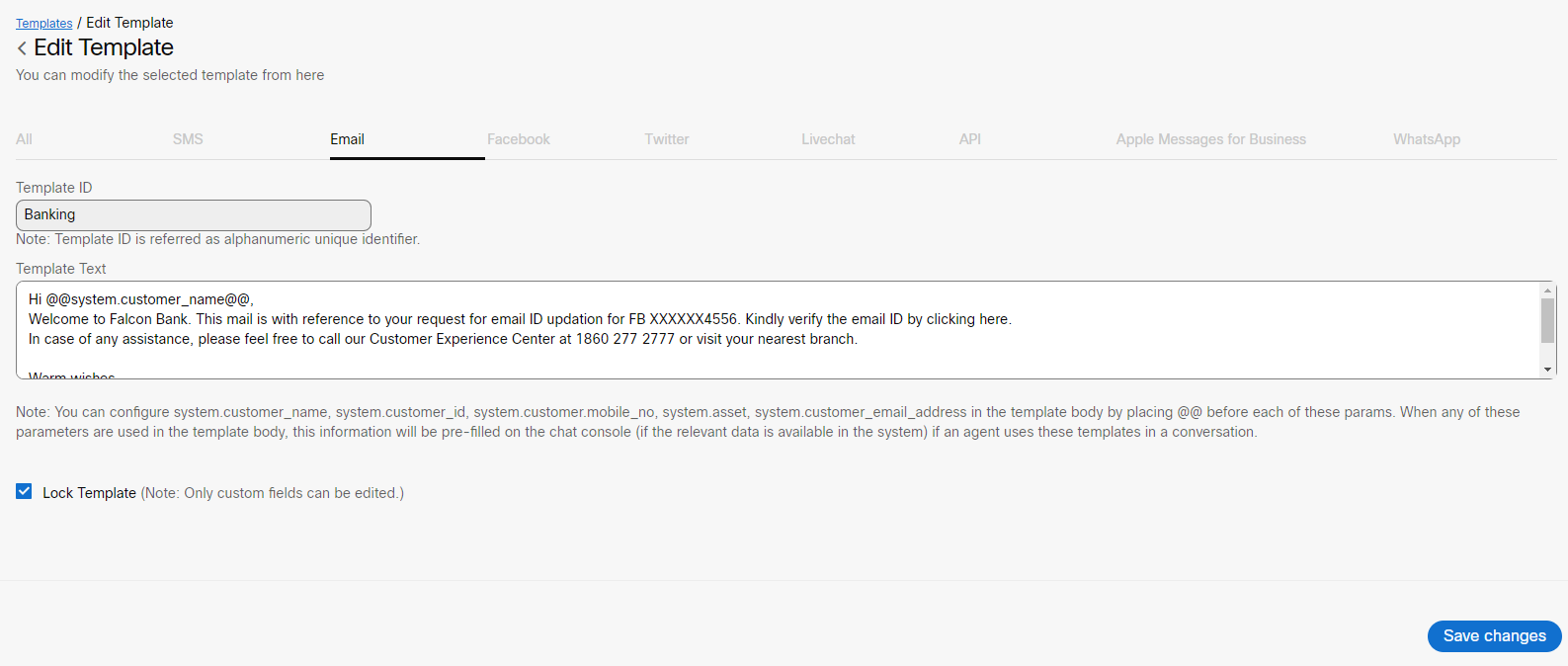
- Make the required changes to the template, and click Save changes.
The success message appears on the screen.
Delete Template
To delete a template, follow these steps:
- Navigate to Customer care console > Settings> Manage > Templates.
- Select a Template group that contains the required template. All the templates in that Template group will display on the right side of the Templates screen.
- Click the Delete icon in the Actions column of a specific template.

A confirmation pop-up window appears.
- Click Ok.
The success message appears on the screen.
Note
Once you delete a WABA template, you cannot add a WABA template with the same name for four weeks from the date of deletion. This time frame holds good for only WABA templates. Whereas, you can create a template with the deleted template instantly for other channels on the Webex Engage application.
Updated over 2 years ago
